Communication with the reverse side of the moon - satellite relay "Tseyutsyao" (Shorty bridge)
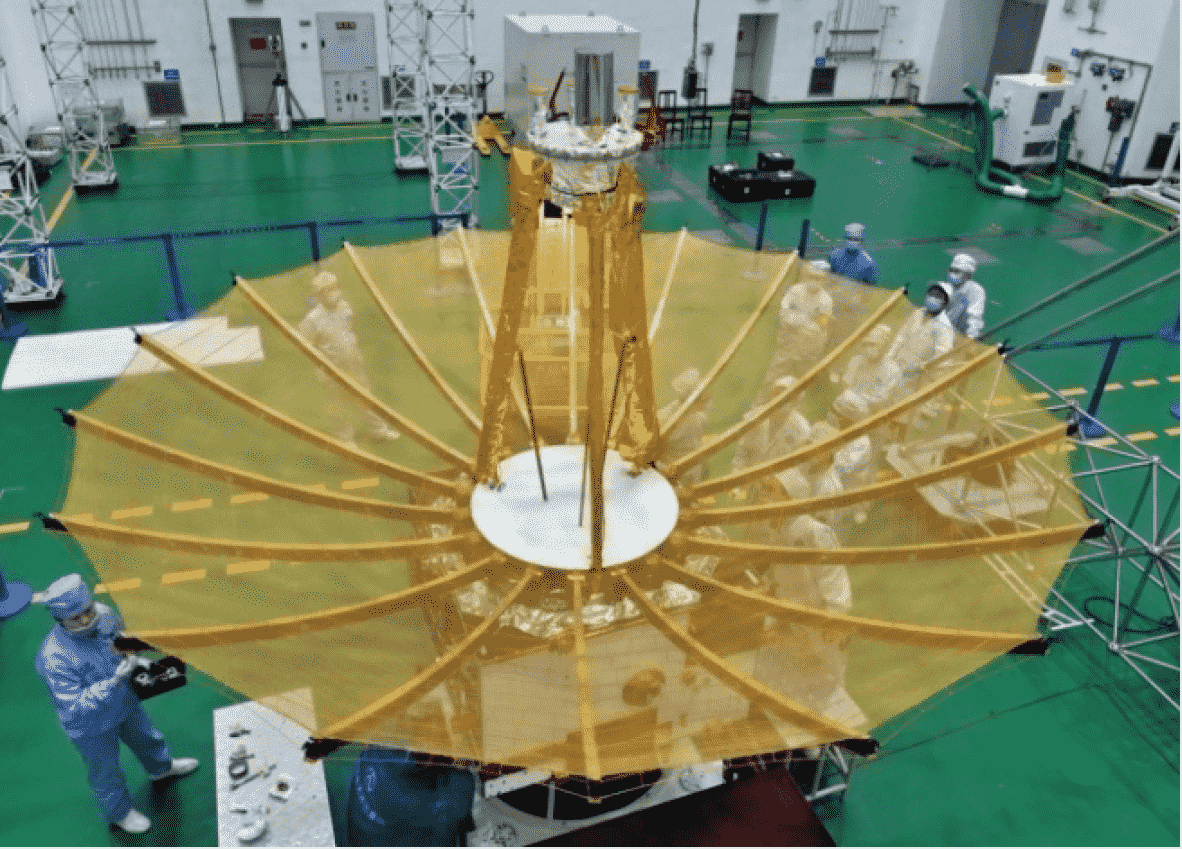
The main thing in a complex technical project is to organize a stable connection between all components.
So the first part of the mission "Chang'e-4" was the organization of the communication channel with the devices on the far side of the moon. Six months ago, the era of radio relay communications began with the reverse side of the moon.
')
How it was done, what data is transmitted between the devices on the Moon (the landing module and the rover) and the transponder satellite beyond the Moon, how the communication with the MCC on Earth (via the space communications center) is organized and with what data transmission speeds - described here.
The communication channel is a thin invisible thread connecting the reverse side of the Moon and the Earth, which should be easy and simple to implement, but reliable from the point of view of node failures, because in the absence of this single communication channel, the devices on the reverse side of the Moon will be lost and provided themselves (for a while automatics).
Previously published materials about the mission "Chang'e-4":
1. The spacecraft "Chang'e-4" made a successful landing on the far side of the moon and sent the first photo
2. On-board video of the processes of preparation and landing, as well as a panorama of the far side of the Moon from Chang'e-4
3. Video of the descent of the rover "Yuytu-2", its first meters on the surface of the moon. Two week sleep on the moon is over
4. Pride and Passion, the story of turning a dream into a space project
5. NASA lunar orbital probe made the first pictures of the China Chang'e-4 station - two pixels of light
6. Module "Chang'e-4" and rover "Yuytu-2" are ready for the second night on the far side of the moon
7. NASA lunar orbital probe made new images of the China Chang'e-4 station - closer and clearer
8. Interesting facts about the history of the Chinese lunar program and the Chang'e-4 space mission
9. The Chang'e-4 mission is the third lunar day. Rover "Yuytu-2" in search of ... stones
10. The mission “Chang'e-4” - scientific equipment on the landing module and the satellite transponder
11. The Chang'e-4 mission is the fourth lunar day for the landing module and the Yuuta-2 rover. Pro cameras and controllers on devices
12. Mission “Chang'e-4” - the fifth lunar day for the landing module and rover “Yuytu-2”
1. The spacecraft "Chang'e-4" made a successful landing on the far side of the moon and sent the first photo
2. On-board video of the processes of preparation and landing, as well as a panorama of the far side of the Moon from Chang'e-4
3. Video of the descent of the rover "Yuytu-2", its first meters on the surface of the moon. Two week sleep on the moon is over
4. Pride and Passion, the story of turning a dream into a space project
5. NASA lunar orbital probe made the first pictures of the China Chang'e-4 station - two pixels of light
6. Module "Chang'e-4" and rover "Yuytu-2" are ready for the second night on the far side of the moon
7. NASA lunar orbital probe made new images of the China Chang'e-4 station - closer and clearer
8. Interesting facts about the history of the Chinese lunar program and the Chang'e-4 space mission
9. The Chang'e-4 mission is the third lunar day. Rover "Yuytu-2" in search of ... stones
10. The mission “Chang'e-4” - scientific equipment on the landing module and the satellite transponder
11. The Chang'e-4 mission is the fourth lunar day for the landing module and the Yuuta-2 rover. Pro cameras and controllers on devices
12. Mission “Chang'e-4” - the fifth lunar day for the landing module and rover “Yuytu-2”
It all started with a legend.

Shorter bridge (Chinese legend)
A long time ago there lived a shepherd named Nulan.
Since he was an orphan, he lived for a long time in his brother's house.
The sister-in-law drove him out, and life covered in a solid fog.
An empty pocket, only an ox, not to be rich to him.
The ox suddenly spoke, saying that he was the constellation Taurus.
In the sky, very surprised by Nu'lan with this news,
And by the way, he said that from Heavenly Father
Once I heard about the Star - He, the celestial weaver.
"She comes down from heaven to bathe in the early hour,
Nobody can compare with her in wondrous beauty.
Steal your clothes and take your eyes off her
Do not let the beautiful queen rush off to her home! ”
Going down to the bank of the river, a good moment to catch
Shepherd Nylan, in one jump, grabbing clothes rather quickly
Stars named Zhinyuy, heard the gentle call of love.
In his soul burned a fire of shining hope.
River water is so warm, Zhinyuy blissfully floated,
A playful wave of her suddenly brought to shore.
But there is no clothes, and she, unhappiness for scenting the depth,
Powerlessly sat not sand, oh, what trouble measure ?!
She urgently needs to return to the starry sky, but how?
Back naked? Heavenly Father will not understand her!
What is she punished for? And maybe she was given a sign?
Fate is changeable, sometimes ... it became interesting ...
Nulan, seeing that Zhinyuy, shedding tears, froze,
And, having directed her clear glance at the sky, wept,
I could not calmly observe her suffering, because evil
He did not want a star at all, then his heart sank with pain.
From the bushes, he went to her, stretching out his clothes, said:
“Please, Zhinyuy, forgive me, I did not know what I was doing,
Take clothes, tired of me, this strange carnival,
But know, I love with all my heart you, such a thing ... "
Zhinyuy dressed and, having flown, sped away quickly into heaven.
The Lord of Heaven did not learn about this adventure.
Null subdued her heart, her eyes filled with tears.
Earthly love - this is her appointment from now on.
Descending from heaven again, Zhinyuy and Nulan found happiness,
And she wove day and night, and he worked in the field,
Life flourished with love, peace and harmony reigned in the family.
Angry Tindi *, having learned about their life free.
His wife, he ordered Zhinyuy return and punish
For her self-will and to part with Nuler.
Vanmu ** executed the order, Vladyka checked everything himself.
The star Chinyuy is burning again, but with the help of deception.
Nulan rushed after his wife, taking a son and a daughter with him,
Heavenly ox helped them all soar to the sky.
They are in the constellation Taurus, no one can help them
Catch up with Chinyuy, they parted forever so ridiculously.
Divided their Milky Way - a heavenly river flows,
No way to cross it, Lord so pleased.
And settled in heaven in the hearts of two forever longing,
See each other, but, alas, they do not meet Bole.
Learned about the great love of magpies and from all over the world
Got together, the bridge forming the hearts of two for joy.
Lord of Heaven allowed them to meet only on day one -
The seventh month, the seventh day of every August. ***
Meeting once in a year, their hearts are full of joy.
Shorter bridge for meetings they were given at the highest command.
And after the meeting, love is kept for a whole year as a gift of spring,
In the hearts of two, it burns, giving pleasure ...
* Tyandi - heavenly lord
** Vanmu - heavenly mistress
*** - Calculus according to the Gregorian calendar
Since he was an orphan, he lived for a long time in his brother's house.
The sister-in-law drove him out, and life covered in a solid fog.
An empty pocket, only an ox, not to be rich to him.
The ox suddenly spoke, saying that he was the constellation Taurus.
In the sky, very surprised by Nu'lan with this news,
And by the way, he said that from Heavenly Father
Once I heard about the Star - He, the celestial weaver.
"She comes down from heaven to bathe in the early hour,
Nobody can compare with her in wondrous beauty.
Steal your clothes and take your eyes off her
Do not let the beautiful queen rush off to her home! ”
Going down to the bank of the river, a good moment to catch
Shepherd Nylan, in one jump, grabbing clothes rather quickly
Stars named Zhinyuy, heard the gentle call of love.
In his soul burned a fire of shining hope.
River water is so warm, Zhinyuy blissfully floated,
A playful wave of her suddenly brought to shore.
But there is no clothes, and she, unhappiness for scenting the depth,
Powerlessly sat not sand, oh, what trouble measure ?!
She urgently needs to return to the starry sky, but how?
Back naked? Heavenly Father will not understand her!
What is she punished for? And maybe she was given a sign?
Fate is changeable, sometimes ... it became interesting ...
Nulan, seeing that Zhinyuy, shedding tears, froze,
And, having directed her clear glance at the sky, wept,
I could not calmly observe her suffering, because evil
He did not want a star at all, then his heart sank with pain.
From the bushes, he went to her, stretching out his clothes, said:
“Please, Zhinyuy, forgive me, I did not know what I was doing,
Take clothes, tired of me, this strange carnival,
But know, I love with all my heart you, such a thing ... "
Zhinyuy dressed and, having flown, sped away quickly into heaven.
The Lord of Heaven did not learn about this adventure.
Null subdued her heart, her eyes filled with tears.
Earthly love - this is her appointment from now on.
Descending from heaven again, Zhinyuy and Nulan found happiness,
And she wove day and night, and he worked in the field,
Life flourished with love, peace and harmony reigned in the family.
Angry Tindi *, having learned about their life free.
His wife, he ordered Zhinyuy return and punish
For her self-will and to part with Nuler.
Vanmu ** executed the order, Vladyka checked everything himself.
The star Chinyuy is burning again, but with the help of deception.
Nulan rushed after his wife, taking a son and a daughter with him,
Heavenly ox helped them all soar to the sky.
They are in the constellation Taurus, no one can help them
Catch up with Chinyuy, they parted forever so ridiculously.
Divided their Milky Way - a heavenly river flows,
No way to cross it, Lord so pleased.
And settled in heaven in the hearts of two forever longing,
See each other, but, alas, they do not meet Bole.
Learned about the great love of magpies and from all over the world
Got together, the bridge forming the hearts of two for joy.
Lord of Heaven allowed them to meet only on day one -
The seventh month, the seventh day of every August. ***
Meeting once in a year, their hearts are full of joy.
Shorter bridge for meetings they were given at the highest command.
And after the meeting, love is kept for a whole year as a gift of spring,
In the hearts of two, it burns, giving pleasure ...
* Tyandi - heavenly lord
** Vanmu - heavenly mistress
*** - Calculus according to the Gregorian calendar
Task
One of the main problems in the study of the far side of the moon is the problem associated with the organization of communication, since the devices on the far side of the moon are not available to communicate directly from the Earth (the reverse side is never visible from the Earth due to tidal capture), therefore for transmitting signals via the “Earth <-> reverse side of the moon” channel, a separate and special repeater satellite is needed for communication.
With the help of the repeater satellite it was planned to perform the tasks:
- to organize (the first in the world) data channel "the reverse side of the moon <-> Earth";
- to organize tracking of the “Chang'e-4” descent vehicle and data transfer when the vehicle performs lunar maneuvers and landing procedures on the reverse side of the Moon;
- transfer to the MCC on Earth the full control of the vehicles (Chang'e-4 module and Yuyuta-2 rover) lowered to the back side of the Moon using the tracking, telemetry and control command transfer subsystem (TT & C - tracking, telemetry and command subsystem) ;
- to receive scientific data independently on separate communication channels from the descent module "Chang'e-4" and the rover "Yuyu-2", to send this data to the MCC on Earth;
- to conduct their own scientific experiments (using an onboard low-frequency spectrometer) and transfer the obtained scientific data to the PCO on Earth;
- carry out shooting on the onboard camera of outer space and transmit photos to the MCC on Earth;
- maintain the data transmission channel “the reverse side of the Moon-Earth” in a working mode for at least 5 years after the start of the satellite’s operation in orbit beyond the Moon (the maximum estimated service life is up to 10 years);
- the software and hardware of the satellite is designed to work with the equipment not only for one Chang'e-4 project, since the life of the Chang'e-4 descent module is one year, and the Yuuta-2 rover is designed to work for three months , but almost doubled this time already, so after the end of the Chang'e-4 project, the satellite repeater will be further involved in new research and for organizing communication channels with new devices on the back of the Moon.
Decision
A unique satellite repeater satellite was developed, which was planned to be put into halo-orbit around the special gravitationally stable Lagrange point Earth-Moon L2, from which it will maintain direct visibility with the Earth and the back of the Moon at any time, withstanding a temperature difference of 300 degrees Celsius.
The engineers of the Chinese Academy of Space Technology (CAST) had only 30 months to develop a repeater satellite.
In December 2015, design work began, two years later, the final satellite prototype was produced, which, after testing and testing, was prepared for launch into outer space.
The space communications team worked together with a group of scientists and engineers who developed and implemented lunar vehicles for the Chang'e-4 project — the Chang'e-4 landing module and the Yuytu-2 rover, the link with which was the main task of their project.
For 2015, the team of space engineers and communications engineers of the Chinese Academy of Space Technology already had experience in the development of satellites, remote space communications equipment and control of lunar spacecraft:
- On November 7, 2007, the first Chinese lunar satellite, Chang'e-1, was launched;
- On October 1, 2010, the Chang'e-2 research satellite was launched, which until July 9, 2011, worked in lunar orbit, and then left it, in 77 days to reach the Lagrange point L2 of the Sun-Earth system (1.5 million kilometers from Earth) for scientific experiments;
- the landing module "Chang'e-3" and the rover "Yuytu", which were successfully planted on the visible side of the moon on December 14, 2013, and the landing module "Chang'e-3" still communicates with the MCC on Earth.
However, the communications engineers of the Chinese Academy of Space Technology had a hard deadline, the launch time of the repeater satellite and its launch into the working orbit could not be disrupted, because in any emergency or abnormal operation of the satellite elements - the launch of the Chang'e 4 spacecraft with the lunar rover "Yuytu-2" on the reverse side of the moon would be impossible in the planned period, postponed or even canceled.
In general, the year 2018 was very tense with the Chinese space communications operators.
But they did it all - a 425-kilogram repeater satellite called “Tseyutsyao” (in translation - “Shorter bridge”) in the Chinese Academy of Space Technologies was designed, produced at its own facilities (even engineers from the Netherlands were connected for a joint scientific additional load - installation of a special low-frequency telescope-spectrometer on the satellite repeater) and launched at the appointed time and with full functionality.
The CAST-100 platform from the Chinese Academy of Space Technologies was used to create the Tseuqiao satellite transponder, and the specialists of the Chinese company DFH Satellite Co., Ltd were involved in its design and production. (DFHSat), which works closely with CAST and is owned by China Spacesat.
Satellite platform CAST-100 includes:
- three-axis stabilization system, navigation control system, thermal control system;
- a single-component power unit with 100 kg of anhydrous cesium fuel (hydrazine), with a total load of 130H (newtons), 12 engines — 8 engines of 5H (two for each of the lower sides of the cube) and central 4 engines of 20N;
- the power supply system of the on-board systems consisting of two solar batteries (the maximum output power of the solar battery is about 800 W) with an area of 3.8 m2 and a high-energy lithium-ion battery pack of 45A / h.
The total weight of the satellite transponder is 425 kg, it has a cuboid shape with a size of 1.4 m × 1.4 m × 0.85 m, its body consists of an aluminum honeycomb sandwich structure.
The following systems were added to the CAST-100 satellite platform as a payload (primary and secondary):
1) The main load is a radio repeater.
The radio repeater system of the Tseutqiao satellite transponder operates in the X-band and in the S-band.
X-band is used to communicate with the landing module "Chang'e-4" and the rover "Yuytu-2" - four channels are organized with a data transfer rate:
- “Rover \ Landing Module <-> Repeater Satellite” direction 256-280 kilobits / s;
- “Satellite Repeater <-> Rover \ Landing Module” direction is 125 bps.
S-band is used to transmit data to Earth - one channel is organized with a data transfer rate of 2 megabits / s.
TTC & C telemetry data (USB + VLBI) is transmitted at a speed of 1000/2048 bps.
The structure of the radio repeater includes a unique parabolic antenna with a diameter of 4.2 meters, which opens up like an umbrella after the relay satellite enters the working orbit.
2) additional load:
- The Netherlands Low Frequency Experimental Radio Telescope (NCLE) with three five-meter antennas, with which the low-frequency radio emission of the early Universe will be recorded to study its structure;
- a wide-angle laser reflector for measuring the distance between the spacecraft and the ground station, developed by Sun Yat-sen University in Guangdong Province in southern China and will be used to conduct the longest distance measurement in the world using a laser between a satellite-transponder and an observatory on Earth;
- a camera that is also planned to be used for shooting asteroids falling on the opposite side of the moon;
- In order to interest the public in space exploration and moon exploration projects, the Chinese Space Agency (CNSA) offered everyone to write down their wishes on exploration of the Moon and space, and the satellite relay bears on its board the names of tens of thousands of participants in this event and their messages.
Scientific load:
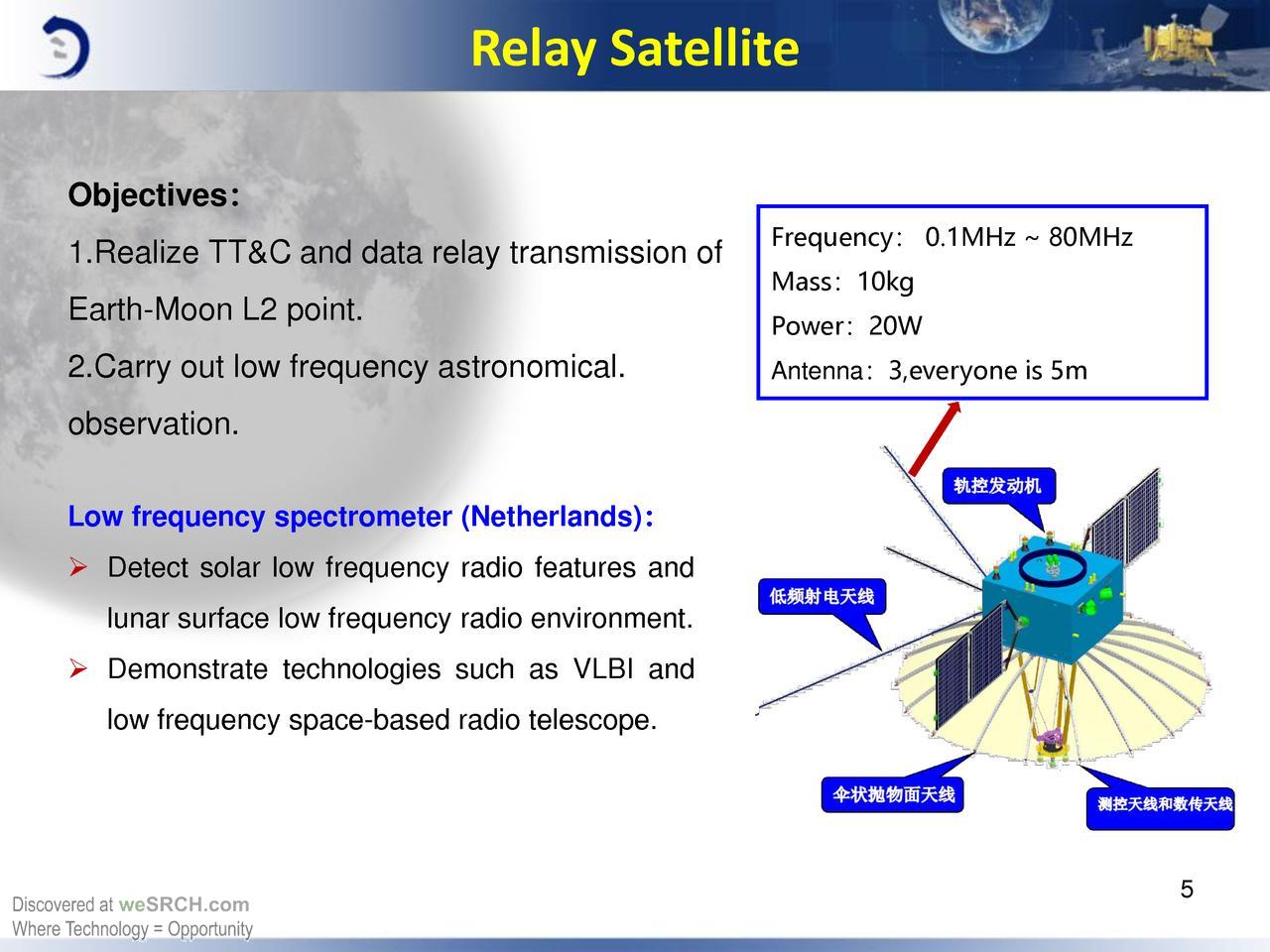
This is the camera installed on the satellite transponder:
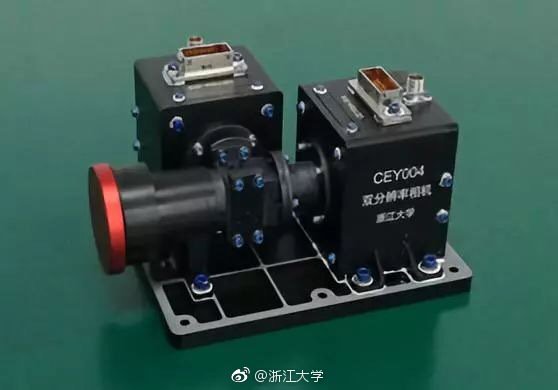
An example of a photo from the satellite transponder:

Laser reflector (drawing):
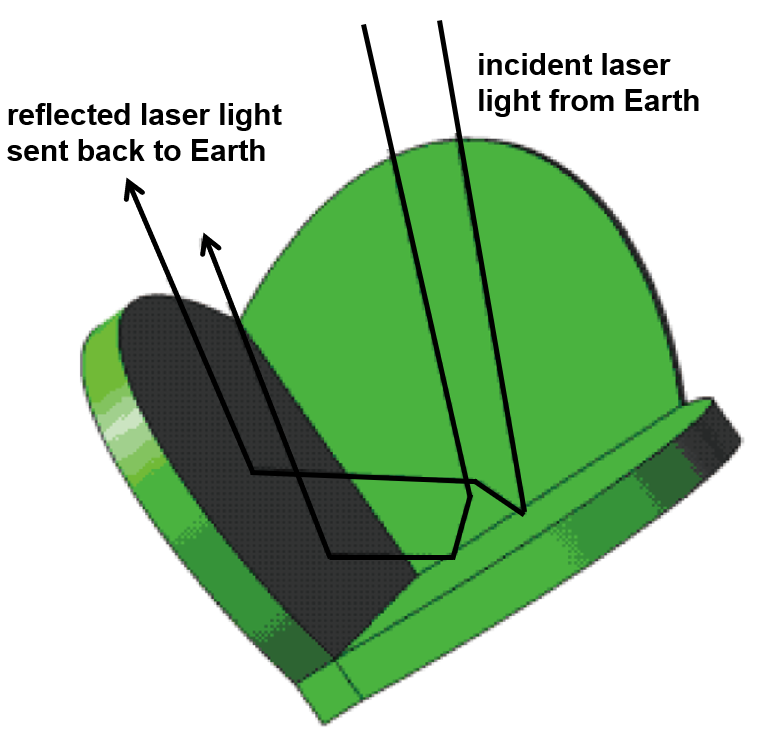
Satellite Relay Tseyutsyao:
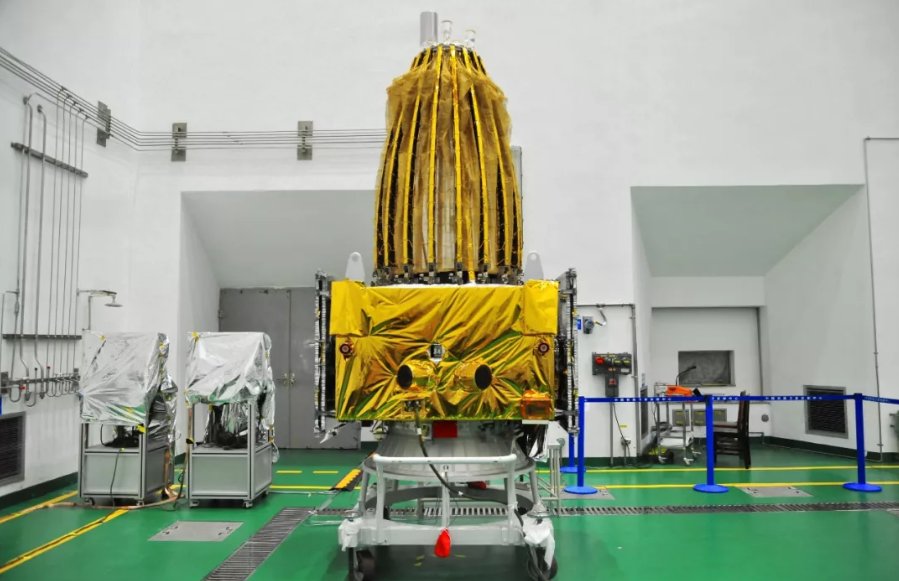
How are the elements of a satellite repeater (antenna, batteries and spectrometer):

With engineers in the lab (for scale):
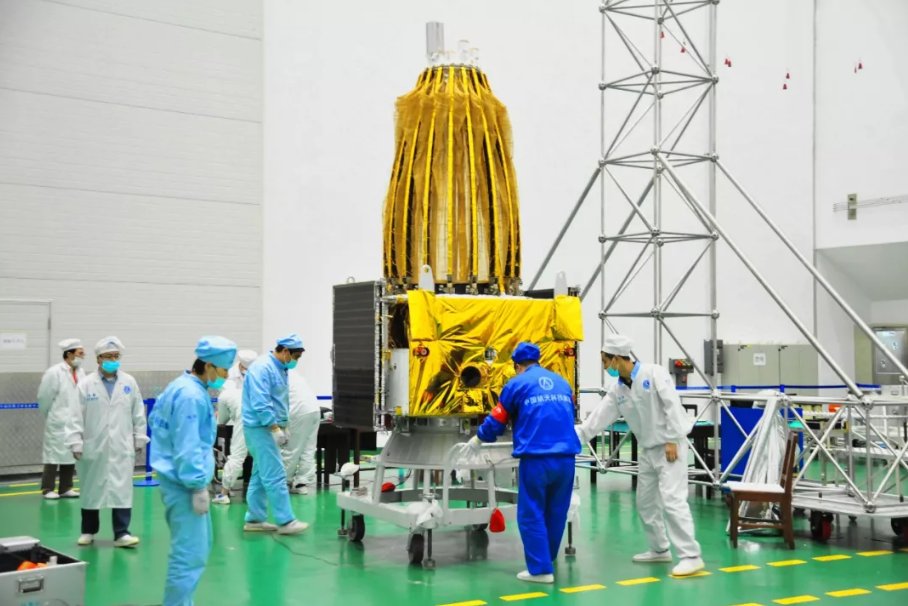
Antenna (the antenna unit itself is to the left, the satellite is already installed on the right):
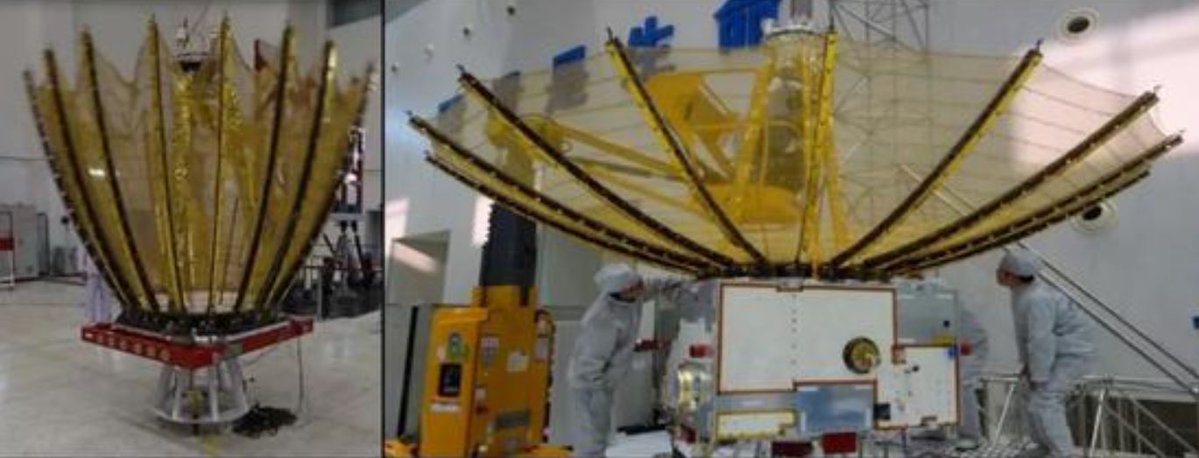
In the expanded form on the tests:
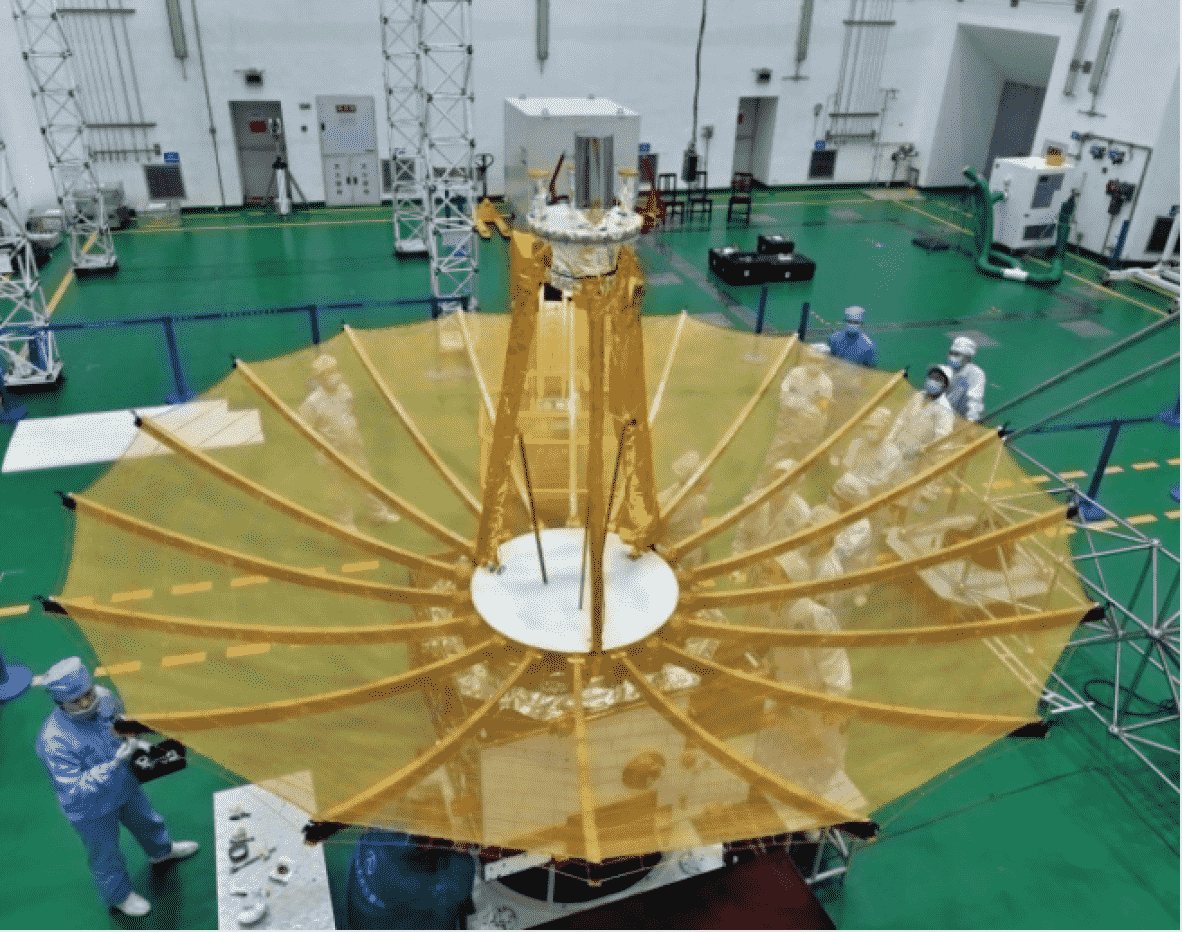
Scientific equipment (three antennas of a low-frequency radio telescope, in a sliding state, each of them is 5 meters long):
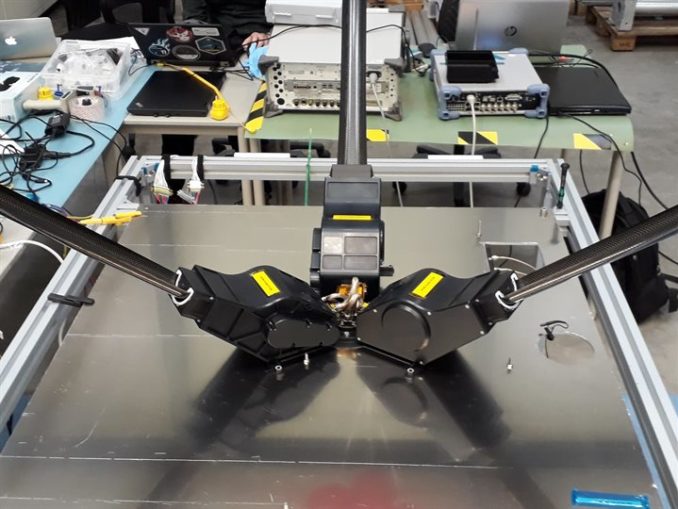
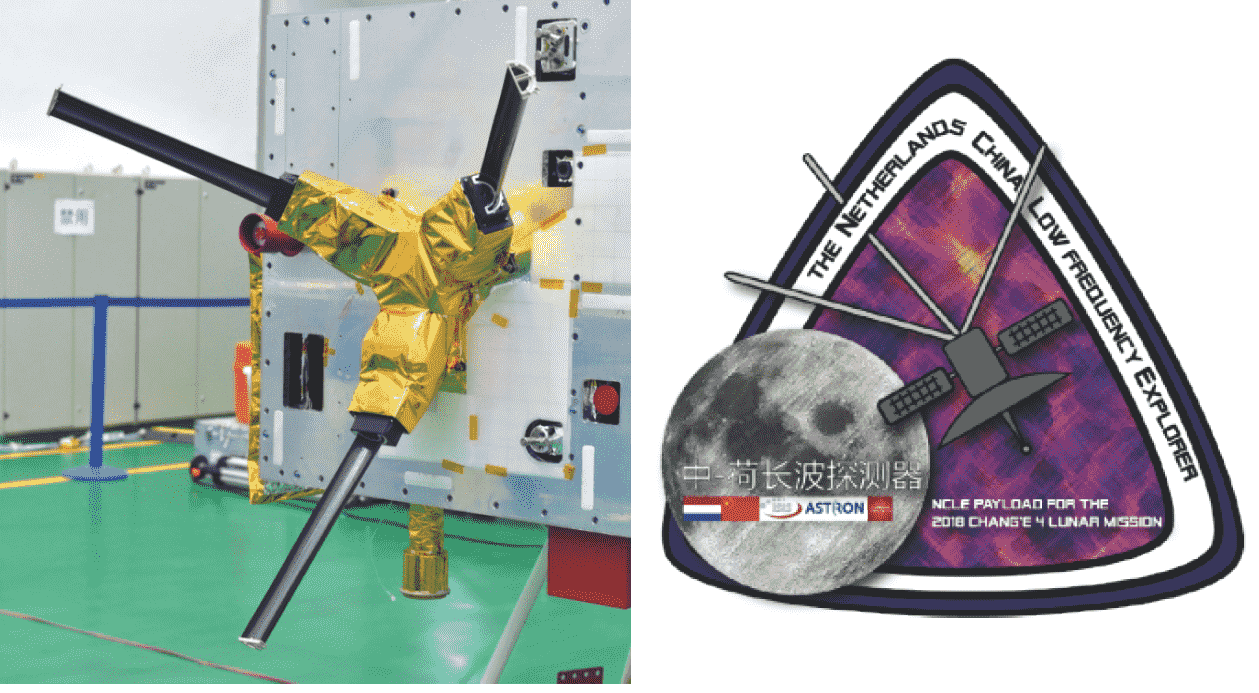

Copy scale 1 to 3 satellite transponders in the museum of astronautics:
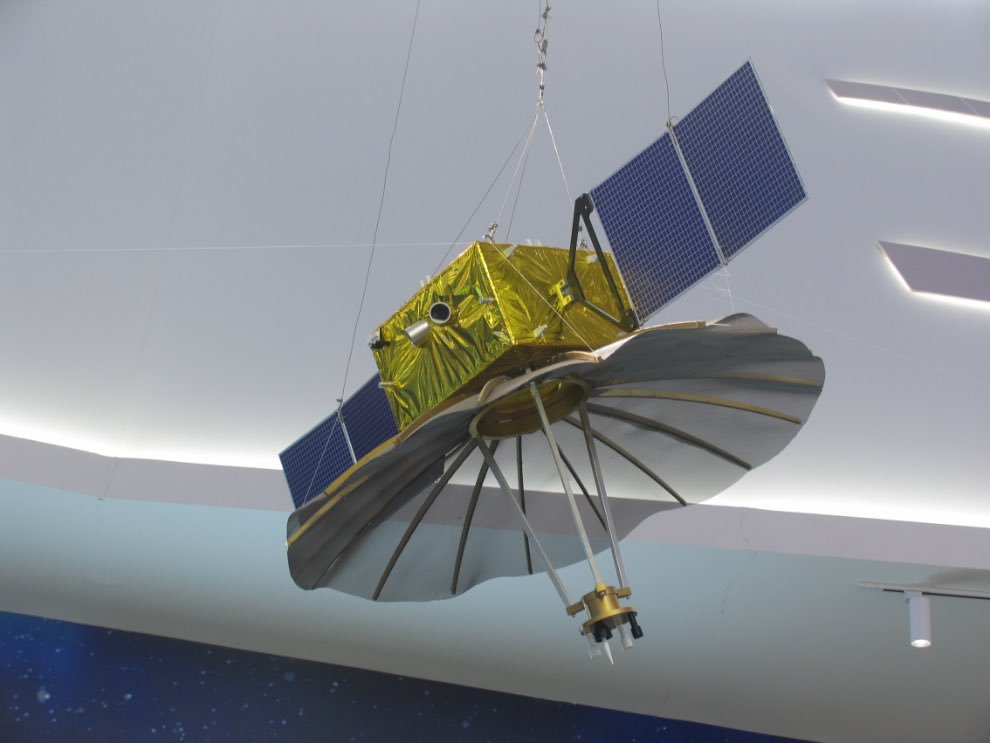

About parabolic antenna umbrella and its creation
Engineers of the Chinese Academy of Space Technology have developed several antenna options for the repeater satellite, including an umbrella in the form of an umbrella with a diameter of 420 centimeters in the opened form.
The design and manufacture of such an antenna involved ... textile technologists and watchmakers.
Only by working together, communications engineers and specialists from the watch and textile industries in the laboratory of the Chinese Academy of Space Technologies were able to solve the difficult task of grouping the smallest elements of a metal grid of an antenna and its 18 edges so that it could be in the folded to the right size for transportation and launch and in the open space she was able to turn around like a beach umbrella.



Antenna elements withstand temperature changes of more than 300 degrees Celsius.
Dozens of tests and programs for testing antenna components and their general assembly were carried out in special bench laboratories of the Chinese Academy of Space Technologies before being installed on the satellite repeater.
The antenna includes a special drive mechanism for controlling direction tracking, which allows you to control the direction of the antenna in the design range in increments of up to 0.2 °.
Visualization of the deployment of the antenna in outer space:
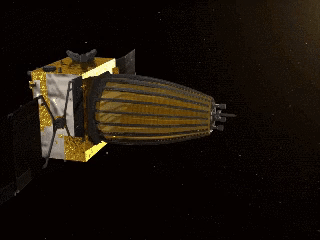
Antenna elements are affected by low-temperature environmental conditions. The temperature of some ribs, tension cables, metal mesh and other components on the antenna will fall below -200 ° C, which should be taken into account in its production.
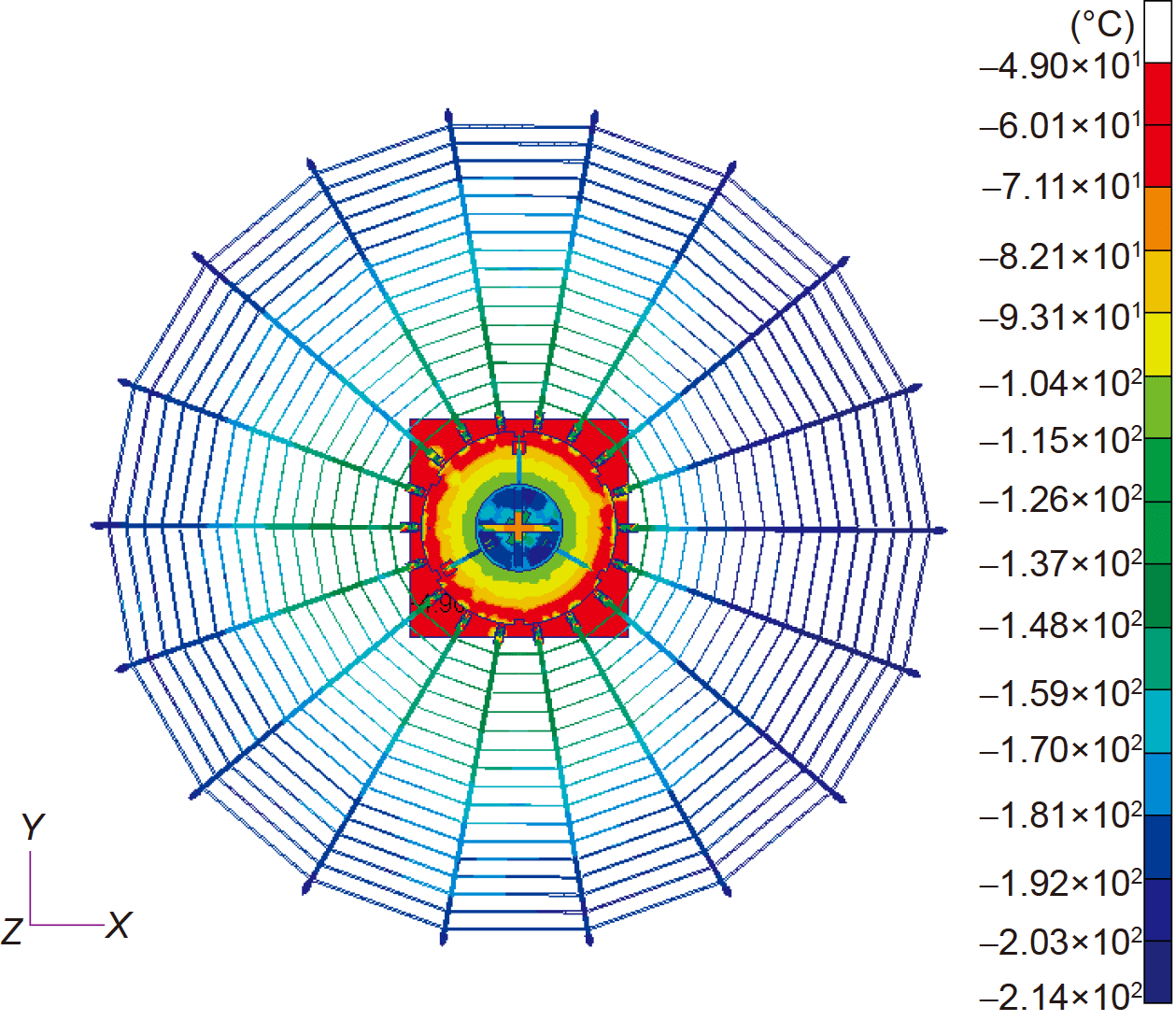
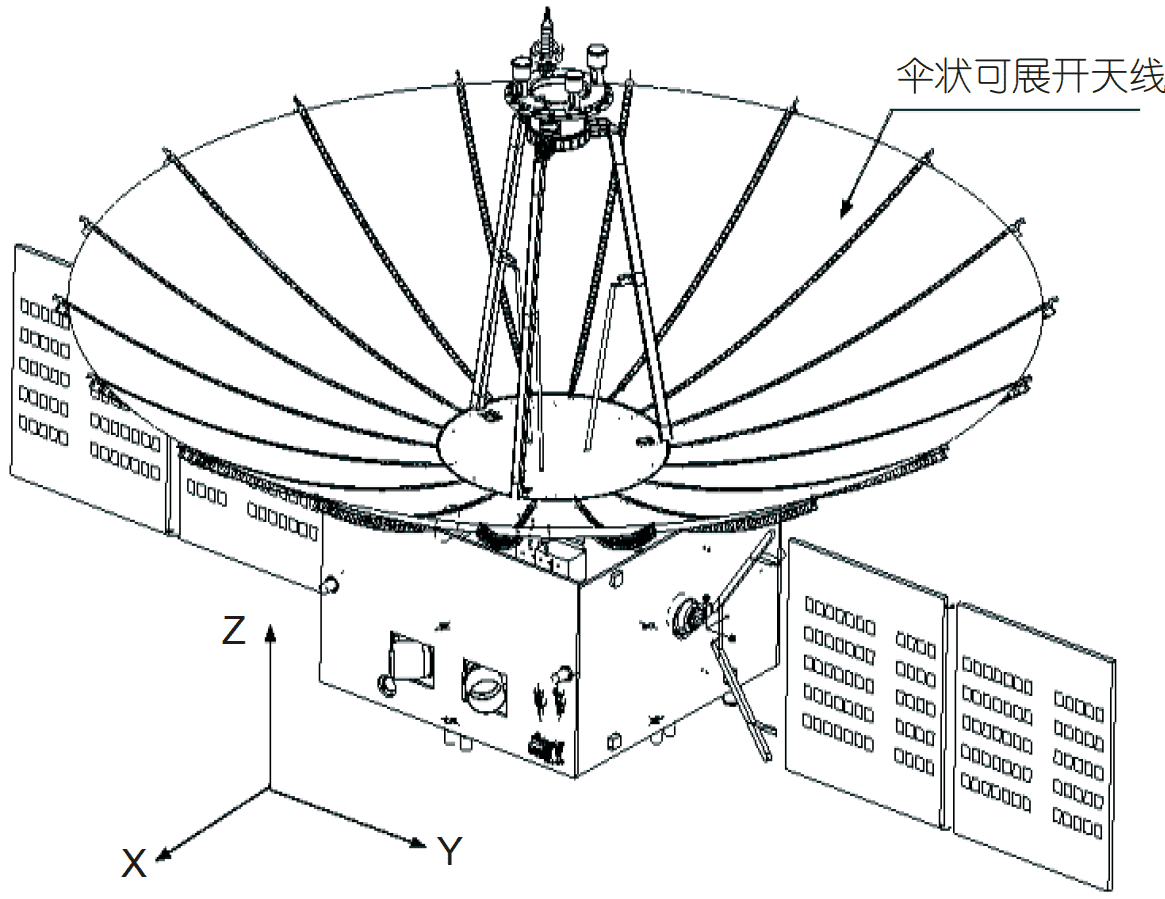
Problems, limited development and production budget
During the development of the satellite transponder, engineers inherited as much as possible the design of the telecommunication system of the Chang'e-3 project, so there were almost no problems with the implementation of the arm of the communication channel Satellite Repeater <-> Devices on the Other Side of the Moon.
The relayed and demodulated data from the Chang'e-4 landing module and the Yuuta-2 rover are relayed by a satellite transponder in accordance with the communication protocol and transmitted to the MCC to Earth via a direct space communications system.
The main problem in the implementation of the shoulder of the communication channel “Satellite Repeater <-> Devices on the Other Side of the Moon” was that the maximum distance of this channel is about 80,000 km, and the signal attenuation at such a distance reaches 210 dB. Therefore, the engineers had to find a balance between the bandwidth of the communication channel, the dynamic change in the positions of the three vehicles (satellite, landing module and rover), as well as the power control system of the radio repeater.
The optimal working scheme for them was as follows: telemetry data is transmitted at any distance from the devices on the surface to the repeater satellite, but the transfer of scientific data (large amounts of data) is organized when the orientation of the two devices (satellite-rover or satellite-landing module) is relatively stable and the power of all devices is enough to organize a channel with the necessary bandwidth.
For example, Yuytu-2 rover antennas need to be configured so that they point to a satellite repeater in order to correctly send and receive control signals, while the rover’s solar panels must be optimally tilted to get a lot of sunlight on them, so that maximize power generation at the time of the data transfer.
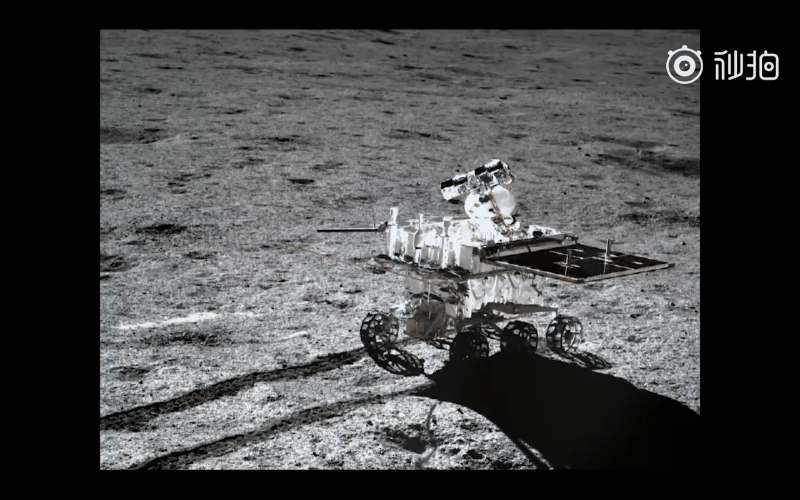
In the shoulder of the communication channel “Satellite Repeater <-> MCC on Earth”, after a satellite retransmitter reaches a halo orbit around the Lagrange point L2 of the Earth-Moon system, the accuracy of the guidance of the relay antenna (distance 4800000 km) is performed.
In the process of calibration, the repeater antenna of the repeater satellite was sent to the Shanghai Astronomical Observatory of the Chinese Academy of Sciences. From Earth, the signal is monitored using a 65-meter ground antenna. The test results show that a high gain relay antenna has a pointing deviation of less than 0.1 °, which meets the requirements for this project.
The satellite relay conducts a daily self-test of its systems — checks key functions and performance indicators (RF modulation characteristics, acquisition time, transfer delay, and data format) of the relay system. Test results are sent to the PCO on Earth, where they are analyzed for compliance with design requirements.
Calibration and testing is necessary because, for a satellite transponder located in a working halo orbit, due to thermal deformation and other factors, the actual orbital orientation of the relay communication antenna will have deflection variations that need to be corrected and checked for changes.
The calculated thermal deformation of the antenna elements (in mm) at different temperatures:

The cost of designing, manufacturing and launching the missions of the Chang'e-4 mission was severely limited. And the ability to even slightly exceed the costs - not something that was not, but on the contrary, the engineers were motivated to minimize parts and elements of the project, refine and expand their functionality in order to reduce the total cost of production and reduce costs.
Therefore, the satellite repeater was originally designed with a relatively small weight (425 kg), so that the cost of its production and launch were minimal.
Have backup satellites been made? This is an interesting question - as an option, several prototypes were made, but only one was launched, the most proven one.
What happens if in space the satellite repeater fails? Of course, in its composition there are several backup elements that are most critical for the project - part of the on-board computer, the power supply system and the radio repeater.
If the satellite reaches its working orbit beyond the Moon, then its efficiency will be maximum here and the service life may be up to 10 years.
The biggest problem that can occur with a satellite repeater is the fatal damage to the antenna, so it was made in the form of a giant umbrella with a mesh inner coating that micrometeorites can damage without disrupting the functional part. And the chance that a large meteorite will collide with a very little satellite transponder.
However, if this happens, then within 30 days it will be possible to restore the communication channel “Earth the Other Side of the Moon” by launching a new repeater satellite and bringing it to a working orbit beyond the Moon.
The engineers of the Chinese Academy of Space Technology had the following new tasks after the creation of the repeater satellite:
- prepare a satellite repeater for launch on a launch vehicle and accompany the launch;
- track its trajectory and send a satellite relay to the moon;
- perform a lunar maneuver to go to a working halo orbit around the L2 point of Lagrange of the Earth-Moon system;
- to test the channel of communication with the satellite until the lunar vehicles of the “Chang'e-4” mission come to the lunar orbit at the end of December 2018;
- to carry out the first communication session with the Chang'e-4 landing module at the end of December 2018; the Chang'e-4 landing module is in orbit of the Moon;
- January 3, 2019 receive data from the landing module "Chang'e-4", which will begin the procedure of landing on the reverse side of the moon;
- to conduct the first communication session with the landing module "Chang'e-4" and the rover "Yuytu-2", which are located on the surface of the far side of the moon.
Launch and operation in outer space
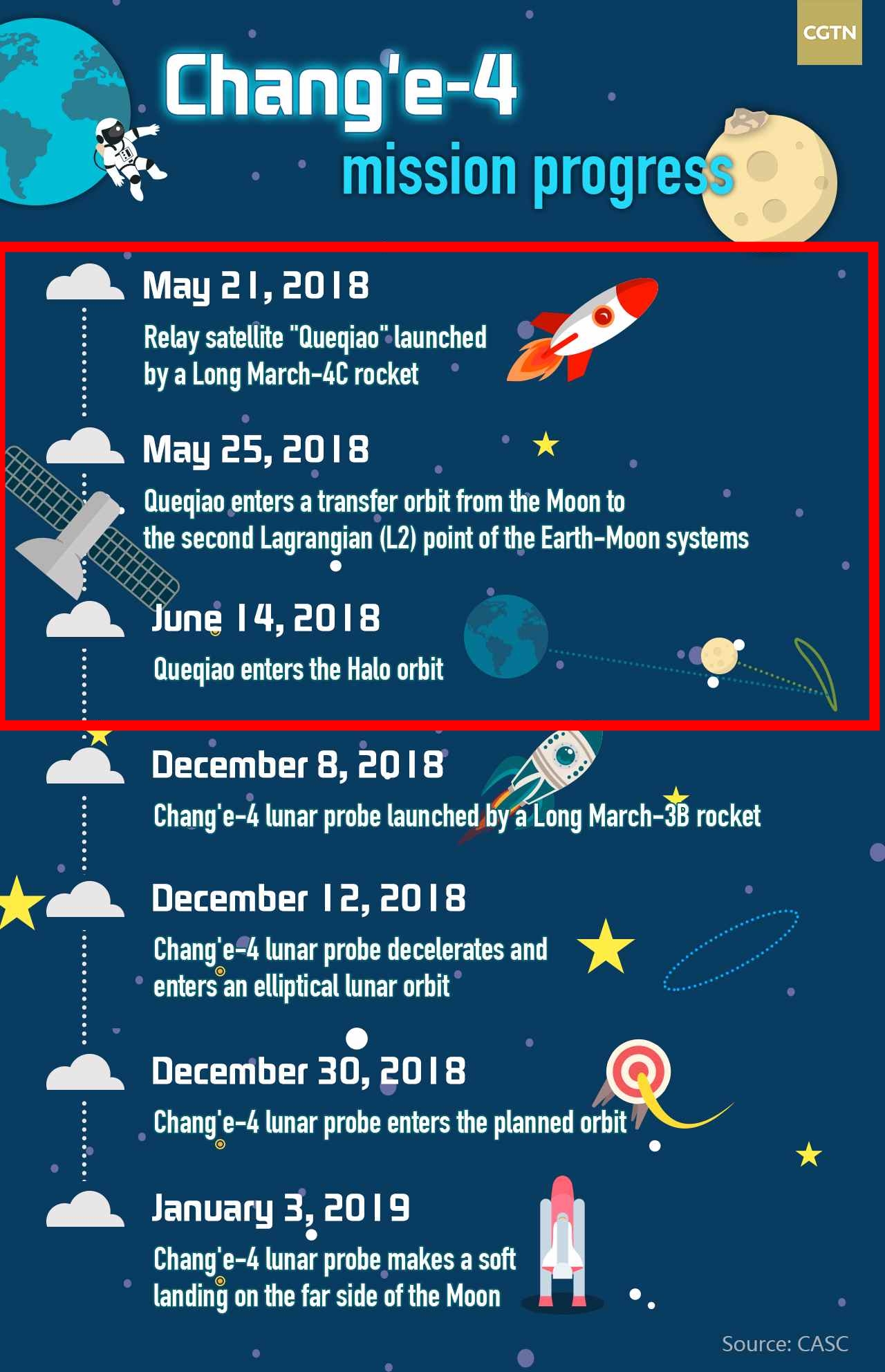
on May 21, 2018: the Tseutqiao satellite (Shorty bridge) satellite relay was launched from the Xichang Chinese cosmodrome.
Start in PCO on Earth:


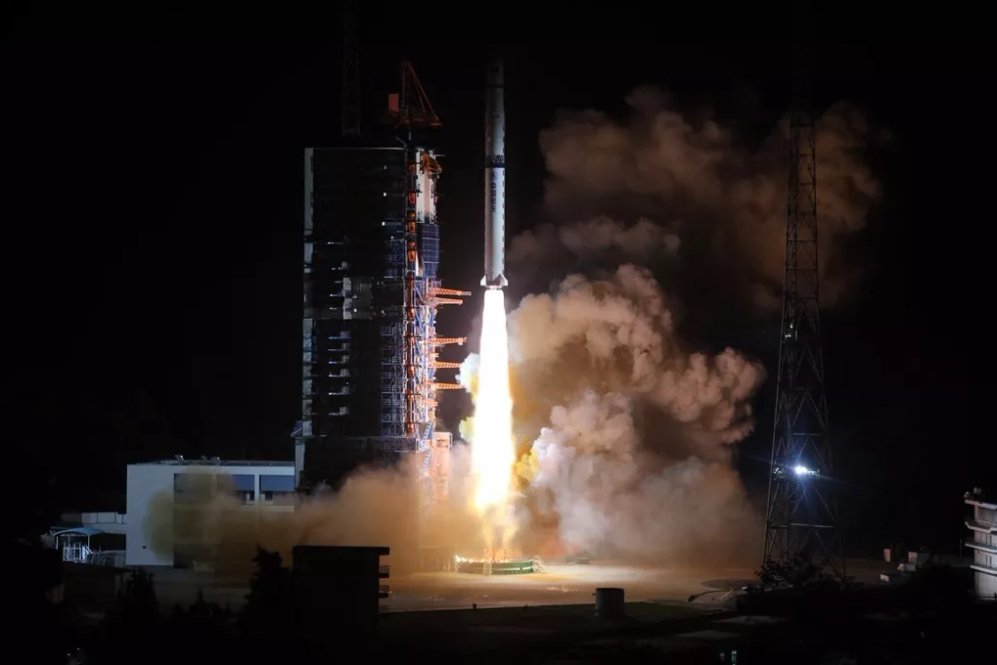
Payload compartment:


The flight path of the Tseutqiao satellite repeater:

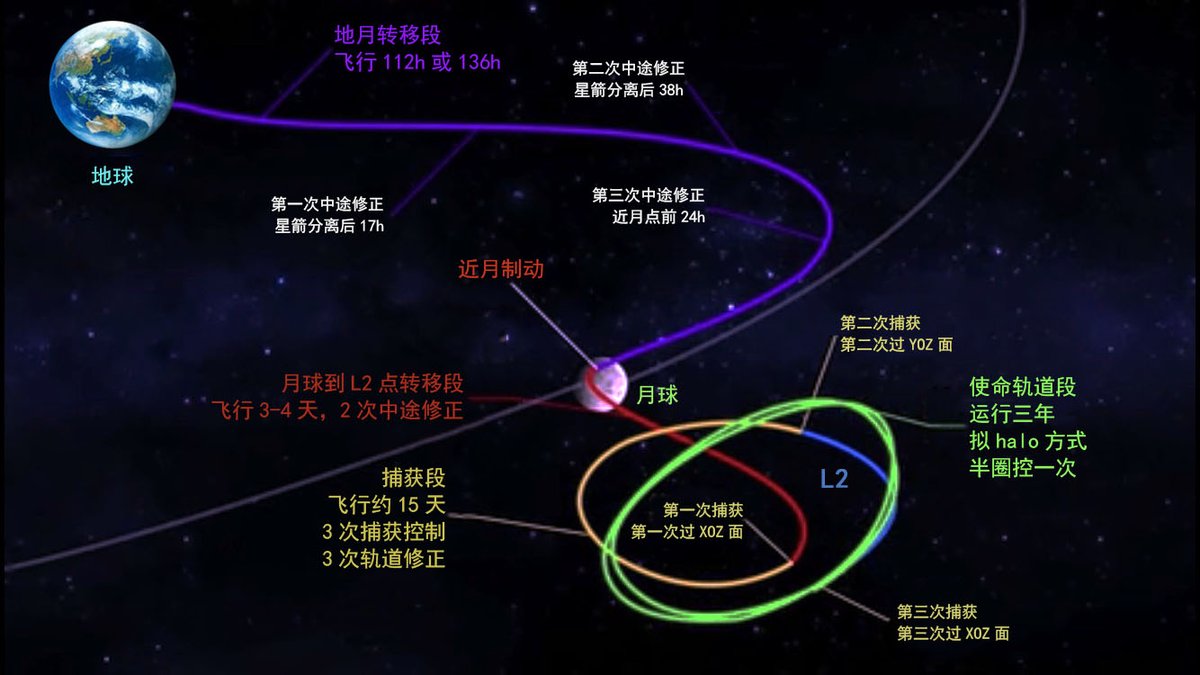
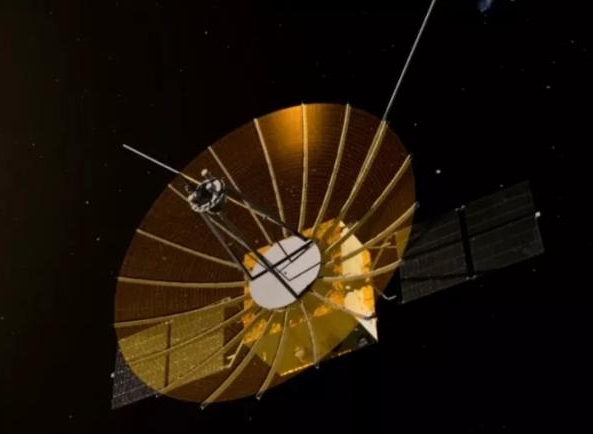
June 14, 2018: The Tseutqiao repeater satellite went into halo orbit around the Lagrange point L2 of the Earth-Luna system, about 65,000 km from the Moon, becoming the first world communication satellite operating in this orbit.
This photo was taken from the Tseuqiao satellite transponder:
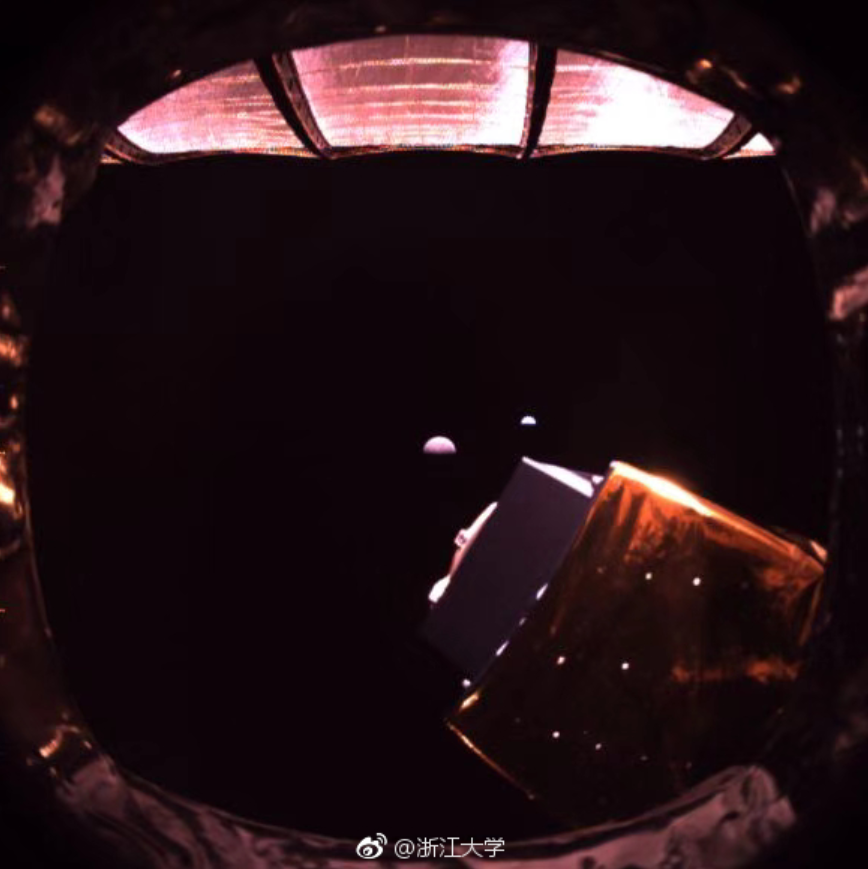
Where the Moon, Earth and satellite elements are visible:

The satellite relay can remain in its orbit for a long time due to the relatively low fuel consumption, since the gravity of the Earth and the Moon balances its orbital motion.
Being in its orbit, the satellite repeater can "see" both the Earth and the reverse side of the Moon. From Earth, the satellite orbit of the repeater satellite looks like a halo of the moon.
The concept of deploying a satellite relay in halo-orbit was first put forward by US space experts in the 1960s (the main contribution to the calculation of such an orbit was made by Robert Farquhar, a NASA mission design specialist more than 50 years ago, in 1968), but was first implemented Chinese space engineers only in 2018.
Libration points of the Earth-Moon system:




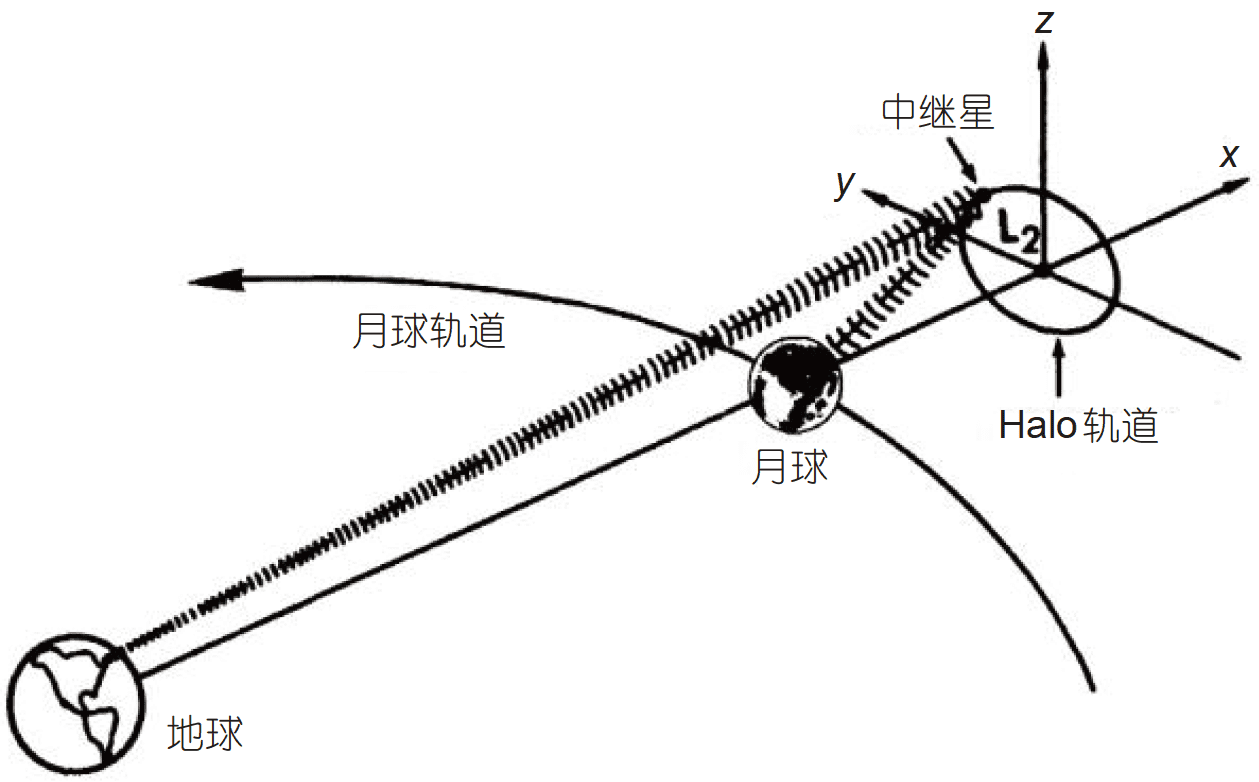
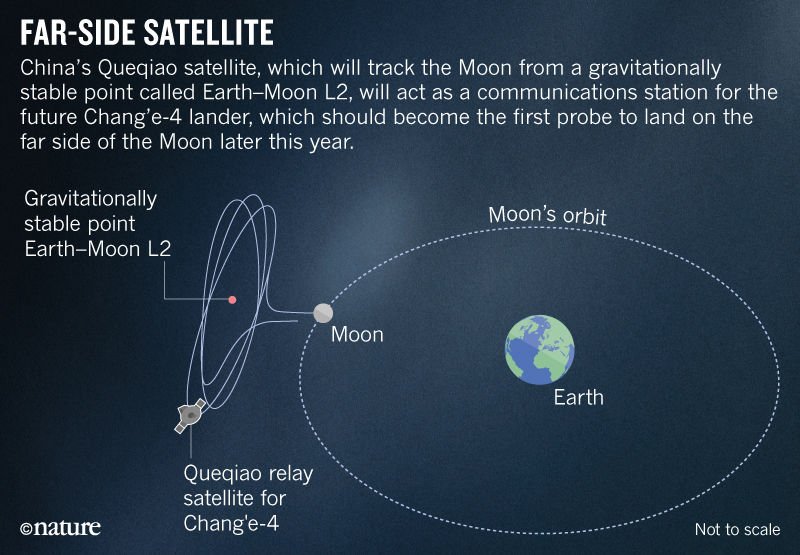
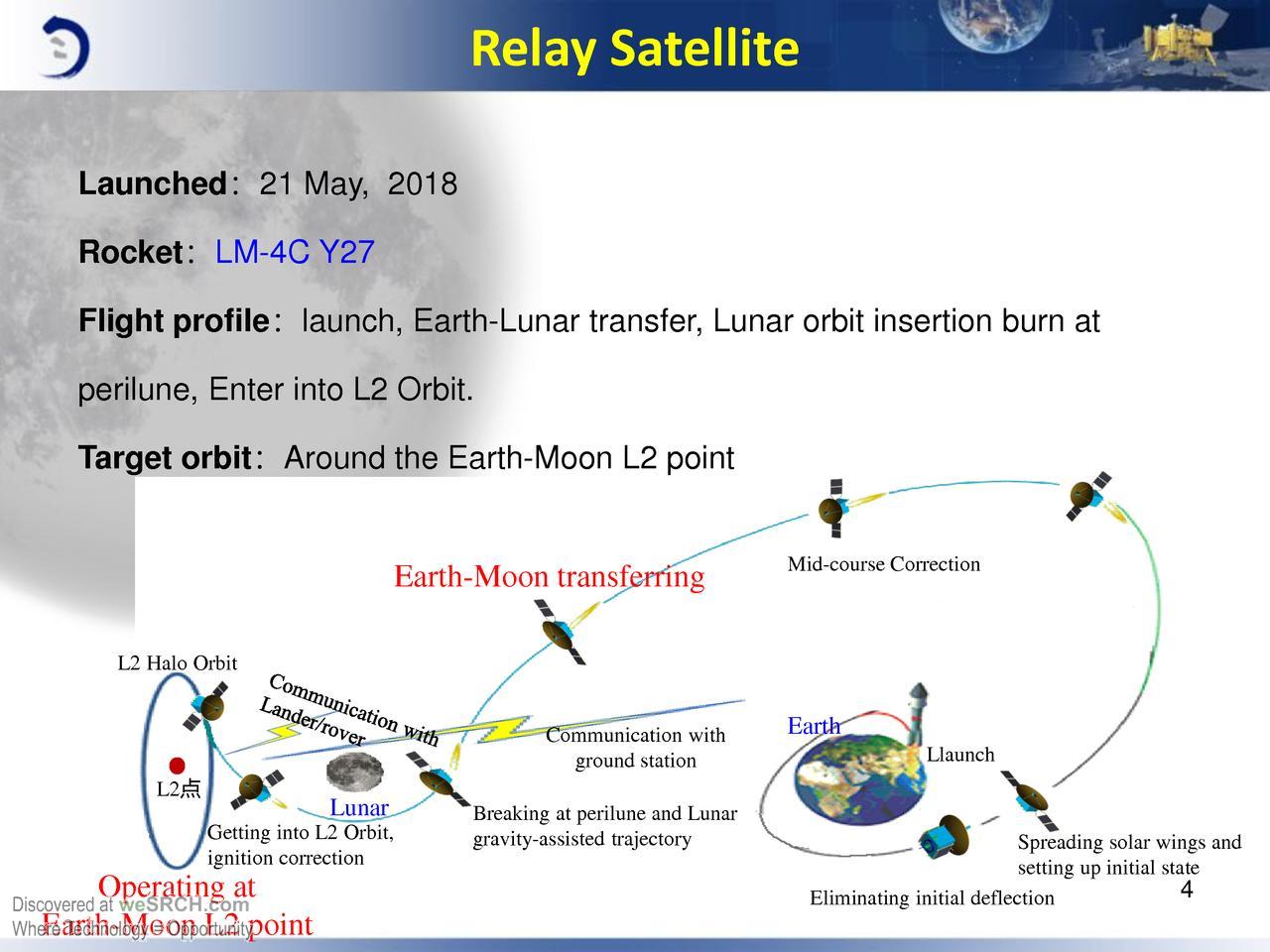
Organization of communication with the Chang'e-4 landing module and the Yuuta-2 rover.
Six months later, as the Tseutqiao satellite repeater reached its working orbit behind the Moon, the second working phase of the project began Chang'e-4 "- the launch into space of the Ch'äe-4 apparatus with the Yuyu-2 lunar rover on board.
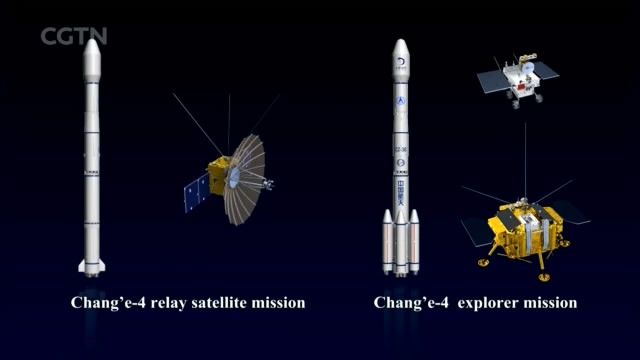

December 8, 2018: The Changzheng-3B launch vehicle with the Chang'e-4 station was successfully launched from the Xichang Chinese cosmodrome.
The flight path of the Chang'e-4 station:

After 110 hours, the Chang'e-4 station reached the Moon and went into its orbit.
It was then that the first combat testing of the Tseutsyao satellite transponder began by organizing a communication channel with the Chang'e-4 station when it flew over the back of the Moon:


Test modes and operation of the Tseyuchiao satellite-transmitter and the Chang'e 4 station devices "(Descent module and rover)

When the Chang'e-4 station started the landing procedure on January 3, 2019, it was here that at the MCC on Earth they switched to full-fledged work with the Tseutqiao satellite relay to receive telemetry and photos from the Chang'e-4 descent module.
January 3, 2019: the Chang'e-4 descent vehicle lands in the Pocket crater on the far side of the Moon. The Chang'e-4 landing gear includes the second Chinese moon rover, Yuytu-2, a modernized version of the Yuytu rover.
Through the satellite receiver "Tseyutsyao" in the MCC on Earth, they receive the first images of the far side of the moon in the landing zone, as well as thousands of shots from the landing camera of the landing gear "Chang'e-4", combining which resulted in such a wonderful video landing on the reverse side of the moon:
Video of the landing procedure on the reverse side of the moon:
After the completion of all stages of the successful landing procedure and the installation of independent communication channels with the Chang'e-4 vehicles (the landing module and the rover), the era of exploration of the far side of the moon began.
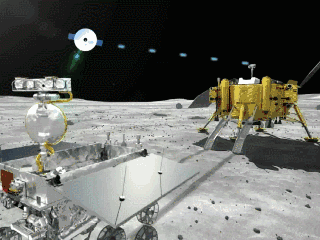

But all of this could not have happened without the Tseuqiao satellite transponder and the communication system organized with the help of it:
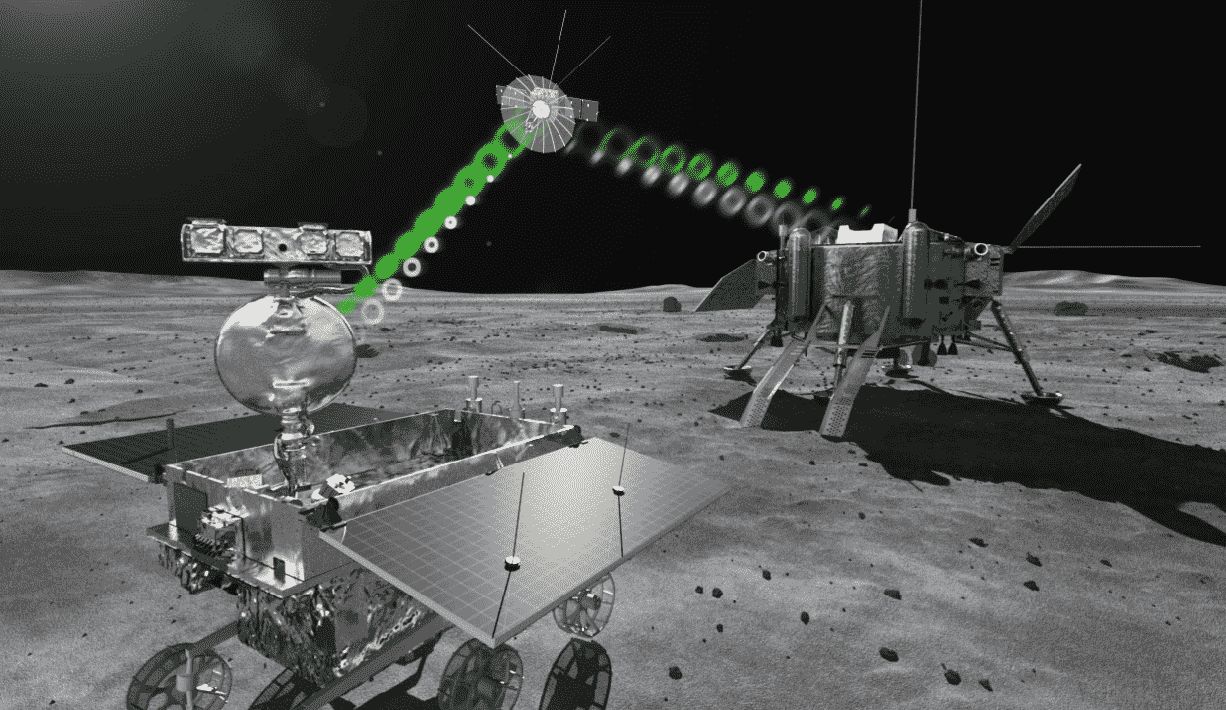
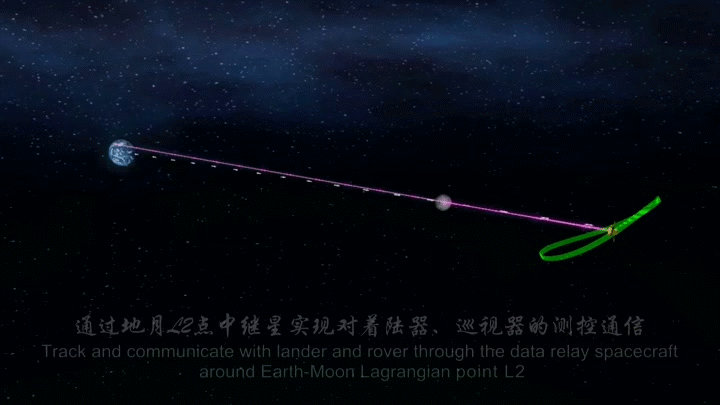
Chang'e-4 project communication organization scheme:
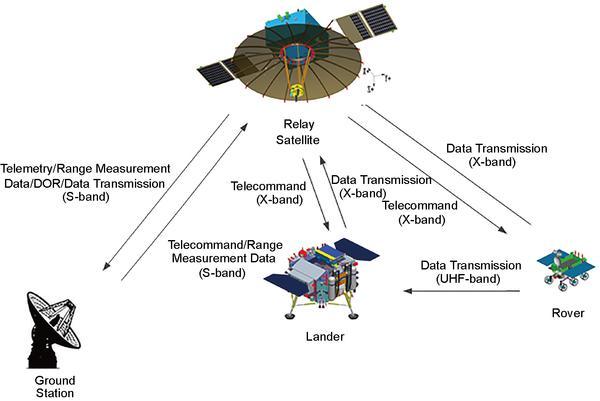
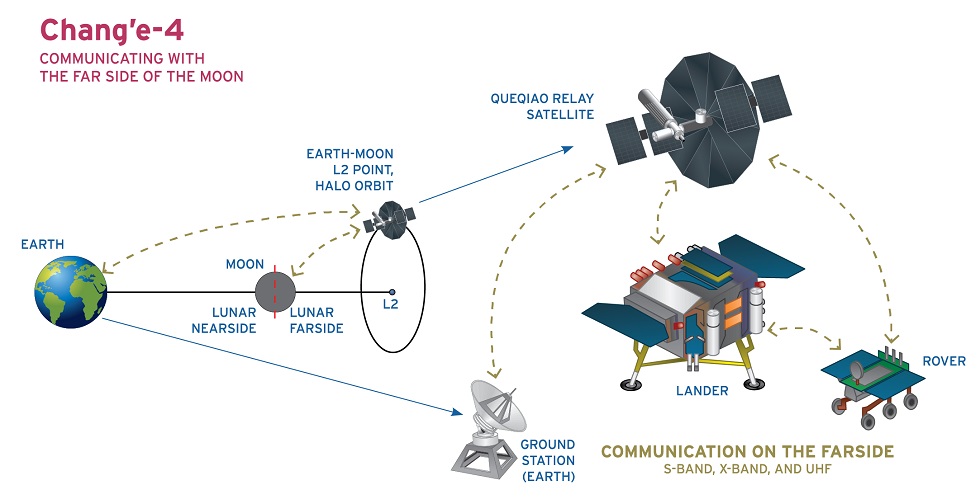
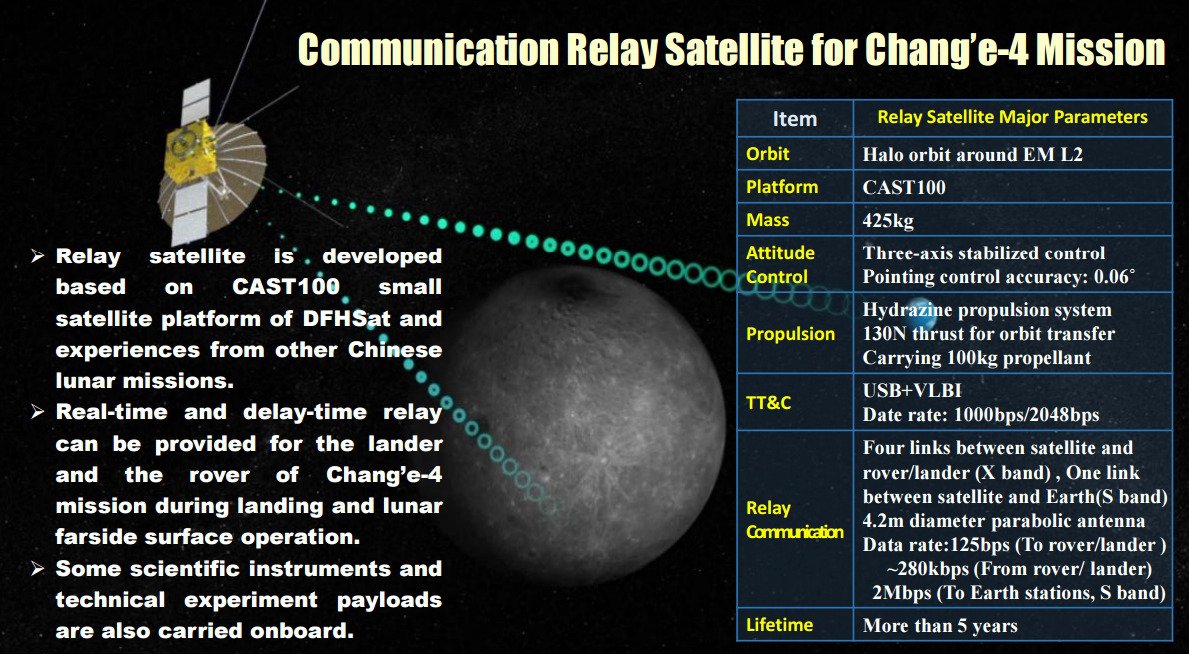
Telemetry data from the Chang'e-4 landing module and Yuuta-2 lunar rover to the Tseuqiao satellite transponder, which then transmits them to Earth at the Beijing Center for Aerospace Control, and then to the MCC, which leads to a delay in receiving data from operators on Earth by up to two or three minutes.
At the center of space communications:
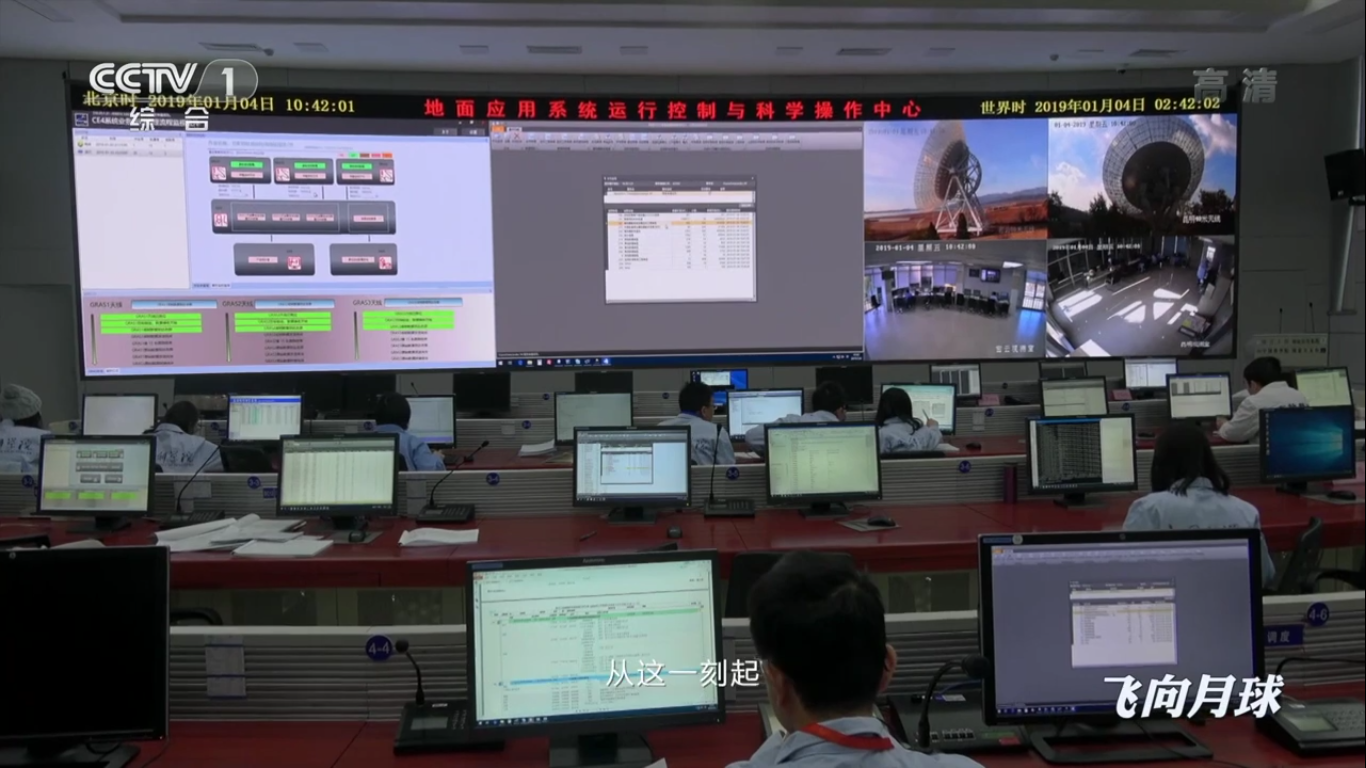

At the mission control center of the Chinese Academy of Space Technology:
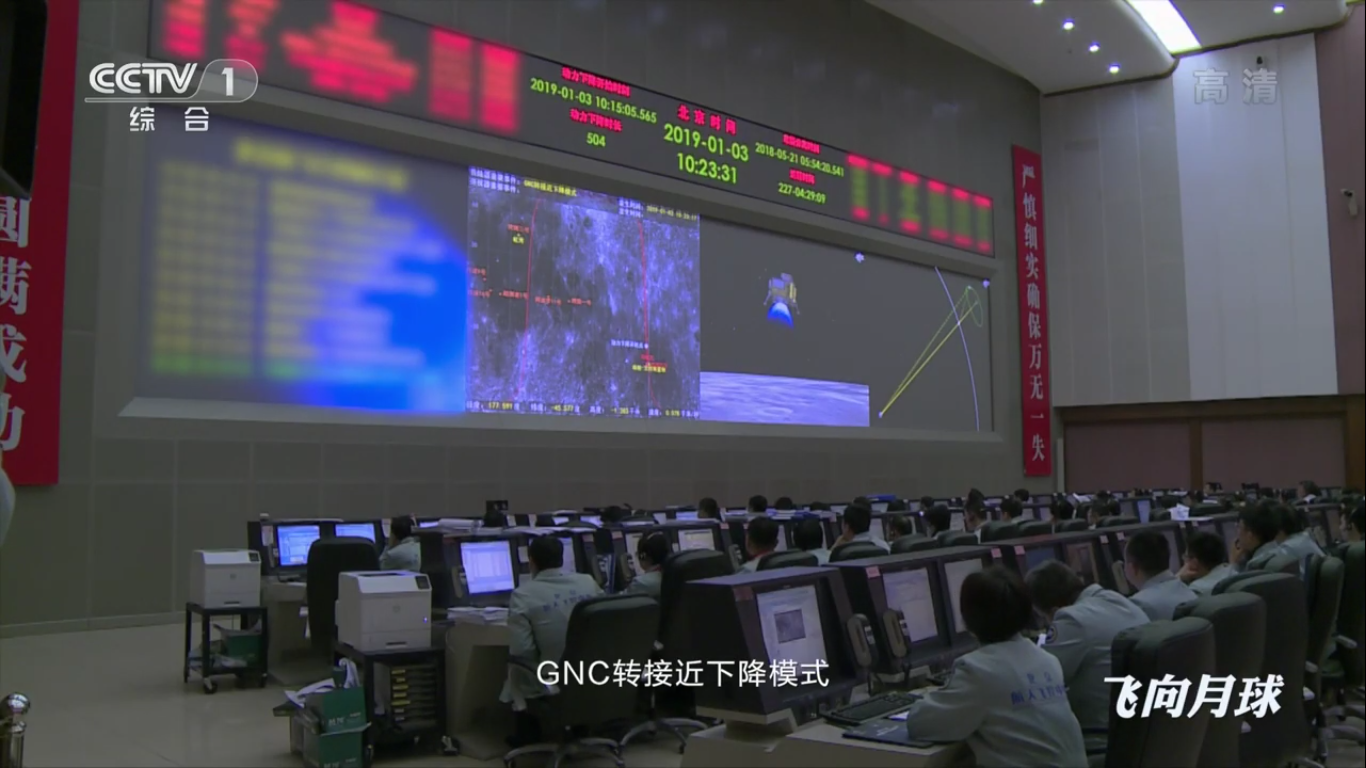

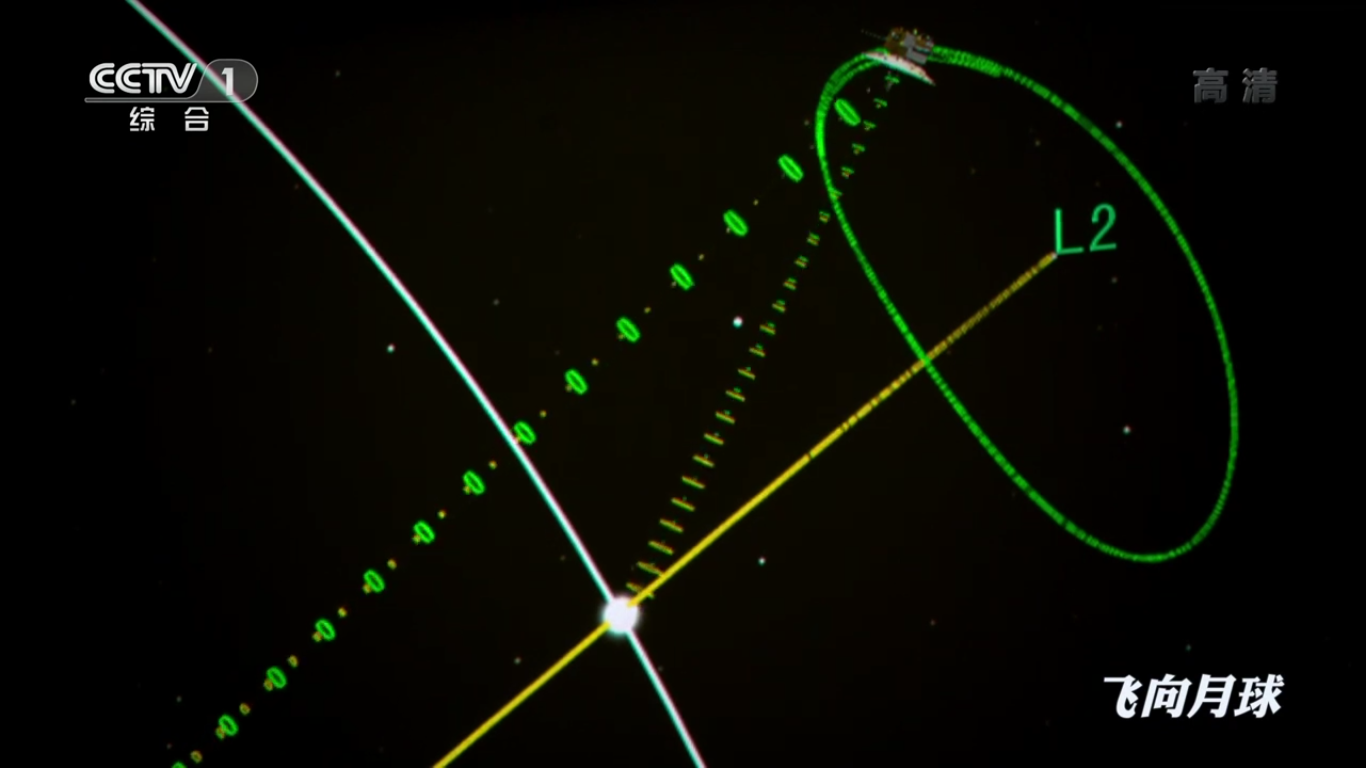
Question: Is it possible to transmit a live broadcast from the surface of the far side of the moon with the help of the Tieuqiao satellite transponder?
Answer: Theoretically this is possible, but the current communication channels cannot meet the requirements for streaming video in real time.
The Chinese Academy of Space Technologies is doing everything possible so that the satellite transponder can work as long as possible, providing future communication for the probes and devices of other countries if they intend to explore the far side of the moon during the life of the satellite.
This is a peaceful science project that everyone can join.
Moreover, when performing a maneuver with a repeater satellite to achieve its working orbit, engineers at the Chinese Academy of Space Technology were able to optimize the number of maneuvers by engines, which saved 16.8 kg of fuel, which can now be used if necessary to correct its orbit and extend service life.

To understand that there will still be new research on the Moon - the scientific satellite constellation that is current on May 5, 2019 .
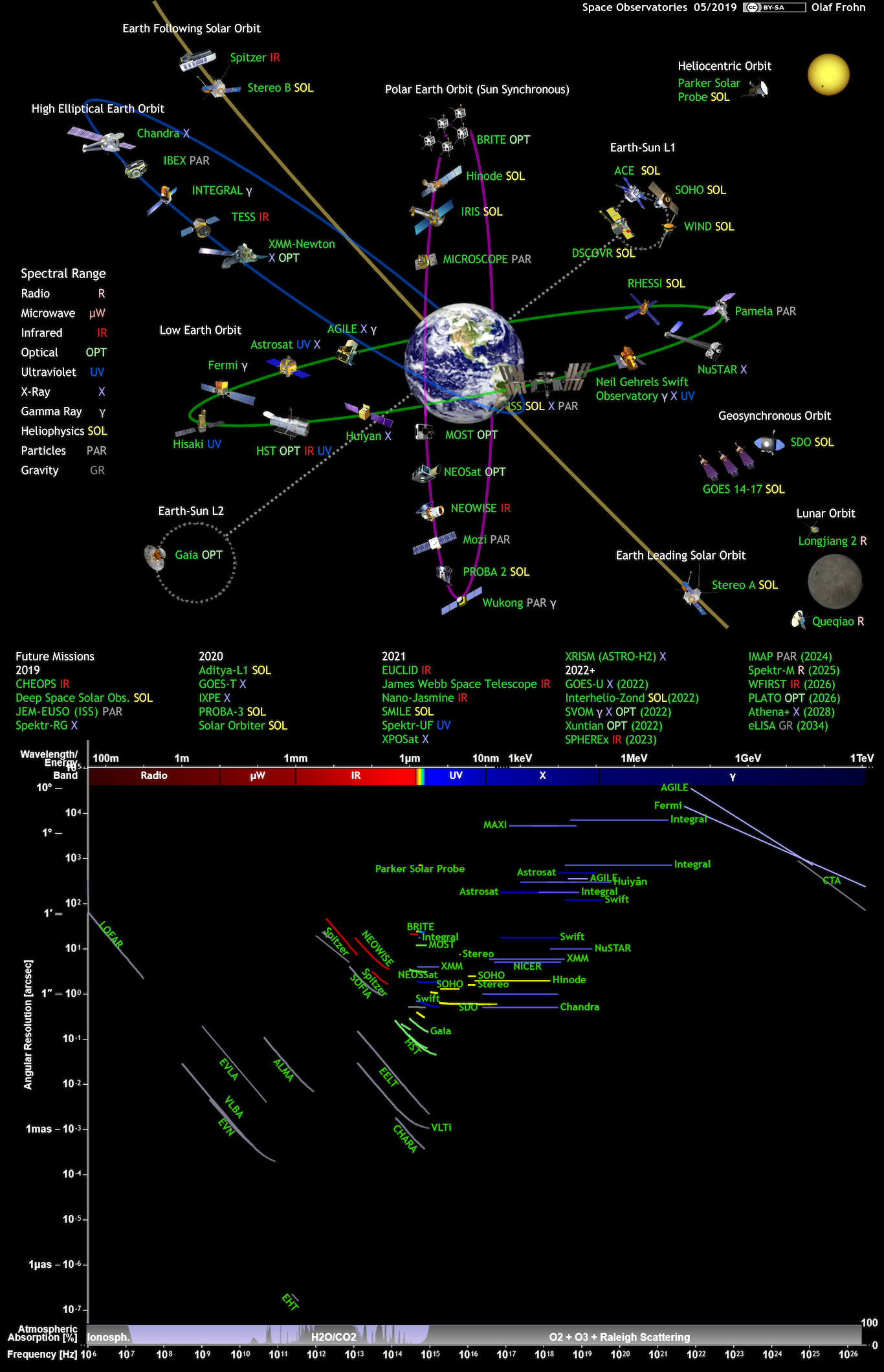
Source: https://habr.com/ru/post/450600/
All Articles